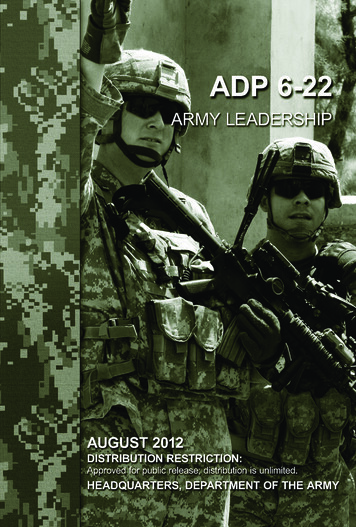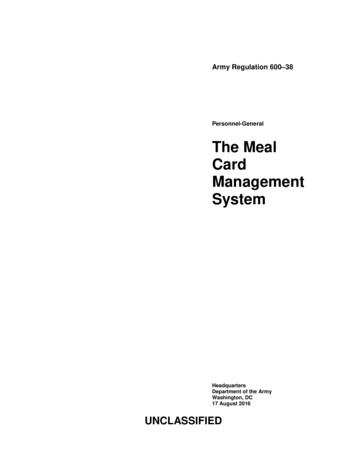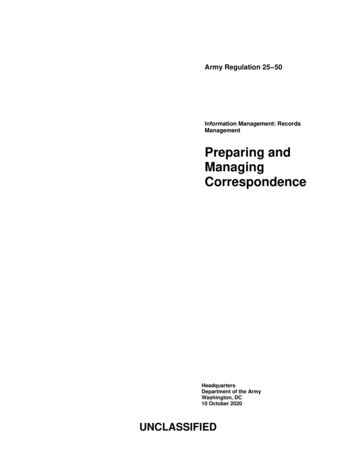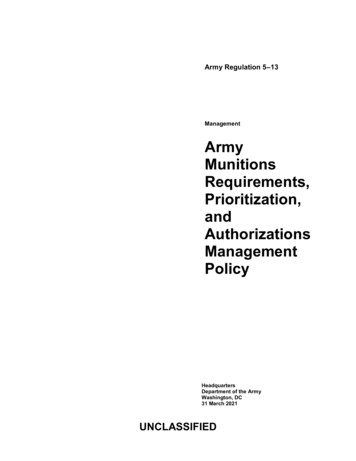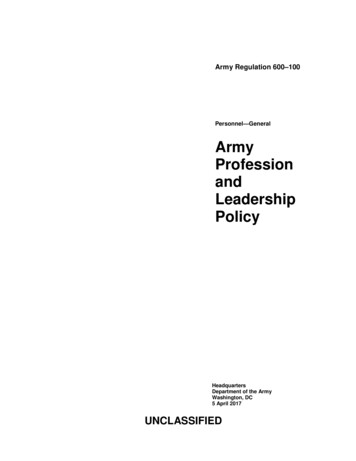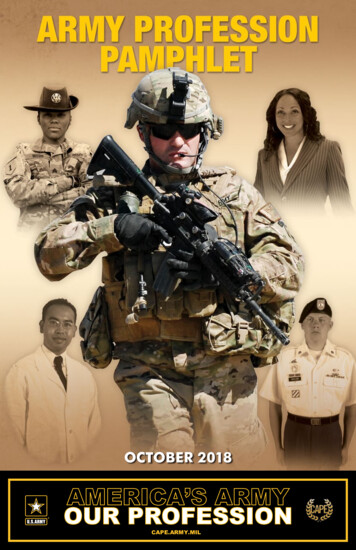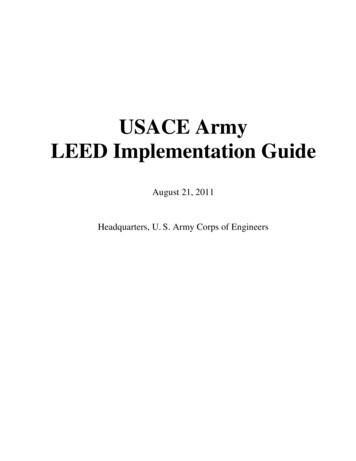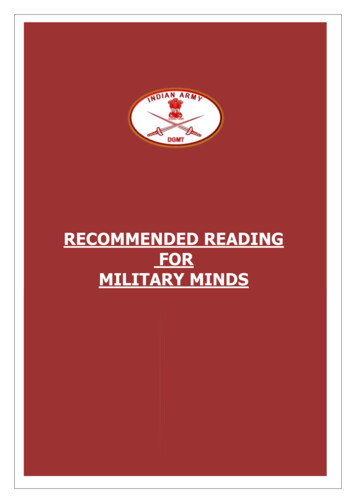
Transcription
SectionPersonal Development Track5INTRODUCTION TOEFFECTIVE ARMYCOMMUNICATIONKey Points1The Communication Process2Five Tips for Effective Communication3Four Tips for Effective Writing4Three Tips for Effective Speakinge an order thatmisunderstood.be misunderstoodbeField Marshal Helmuth von Moltke
Introduction to Effective Army Communication 101Your success as a military leader depends on your ability to think critically andcreatively and to communicate your intention and decision to others. The ability tocommunicate clearly—to get your intent and ideas across so that others understandyour message and act on it—is one of the primary qualities of leadership.While you are a college student, your channels of communication includepresentations and term papers. When you become an Army officer, these channels willexpand to include training meetings, briefings, and operations orders. As you will see,the means to effective Army communication is to develop your speaking and writingskills so that you can deliver any message to any audience effectively. Keep in mindthat communication also includes receiving messages from others through reading andlistening.Early in your Army career, much of your communication is direct. For example,coaching your Soldiers often requires communication that is one-on-one, immediate,and spoken. Later in your Army career, as your leadership responsibilities increase, youwill inform subordinates and leaders through written orders, procedures, memos, ande-mail. This form of communication is indirect—it goes through other people orprocesses, is time-delayed, and written.Your ability to communicate—to write, speak, and listen—affects your ability toinform, teach, coach, and motivate those around you. The good news is that you candevelop these essential skills. This section will discuss the communication process andthen provide you tips for effective writing and speaking.It is difficult to overemphasize the importance of these skills. In military operations,as elsewhere, the inability to write and speak well can have tremendous costs. History isreplete with examples of misunderstood messages. For example, many Civil Warscholars believe that victory at Gettysburg may have depended on how a subordinateinterpreted Confederate GEN Robert E. Lee’s use of the word “practicable.”GEN Robert E. LeePersonal Development TrackIntroduction
102 SECTION 5Day One at Gettysburg: Vague Orders Have Significant Consequences[On the first day of the battle of Gettysburg, Pa., Confederate attacks droveUnion troops through the town to the top of Cemetery Hill, a half-mile south.]The battle so far appeared to be another great Confederate victory.But Lee could see that so long as the enemy held the high ground south oftown, the battle was not over. He knew that the rest of the [Union] Army of thePotomac must be hurrying toward Gettysburg; his best chance to clinch thevictory was to seize those hills and ridges before they arrived. So Lee gave [LTGRichard S.] Ewell discretionary orders to attack Cemetery Hill “if practicable.” Had[LTG Thomas J. (Stonewall)] Jackson still lived, he undoubtedly would have foundit practicable. But Ewell was not Jackson. Thinking the enemy position too strong,he did not attack—thereby creating one of the controversial “ifs” of Gettysburgthat have echoed down the years.James M. McPhersonsenderthe person whooriginates and sends amessagereceiverthe person who receivesthe sender’s message, orfor whom the senderintends itnoisewhatever interferes withcommunication betweenthe sender and receiver,from the wording usedto audience distractionsto bad handwritingfeedbackthe receiver’s responseto the sender’s message,which can indicateunderstanding, lack ement, desire formore information, andso onThe Communication ProcessAs you will see, the Gettysburg vignette illustrates the parts of the communications process.Lee was the sender. He sent the message: Attack Cemetery Hill. Ewell, the receiver, readthe words “if practicable,” decided that Union artillery on the hill made an attack not“practicable,” and did not attack.The words “if practicable” made the message vague. (Who and what should define “ifpracticable”?) Obstacles to communication, such as this lack of clarity—along with otherconsiderations, such as the demands of time, the ease of understanding the sender’s speech,the ability to read the sender’s handwriting, or the distractions in the area—make up whatcommunications theorists call noise. Noise works against the clarity of communication.Looking again at the vignette above, you find that Lee never checked with Ewell tosee if he understood Lee’s intent: “What do you intend to do?” Ewell never checked withLee to clarify the message: “What do you mean by ‘if practicable’?” The communicationprocess included no feedback. Assume for a moment, as some historians do, that Leeintended that Ewell attack Cemetery Hill immediately and decisively. (These historiansargue that Lee was used to issuing such vague orders to the aggressive Stonewall Jackson,who had died a few months earlier.) Throwing Billy Yank off the hilltop might well haveallowed Lee to command the battlefield, perhaps even forcing the advancing Union armiesto withdraw. That might have led to Lee’s domination of southern Pennsylvania, chokingoff Washington from the North and ending the war on the Confederacy’s terms.If that were Lee’s intent, the message failed. Ewell did not attack. The Union held ontothe high ground and won the battle two days later—the beginning of the end for theConfederacy.There’s an important lesson in all this: Effective communication occurs when the receiver’sperceived idea matches the sender’s intended idea. The receiver understands what the sendermeans, not just what the sender says or writes. But how do you ensure that occurs?Five Tips for Effective CommunicationThese five tips will help you eliminate noise and ensure that your receiver understandsyour message.
Introduction to Effective Army Communication1. Focus your messageEvery academic, business, or military message you will ever produce will fit into one of twocategories: Action-and-information messages ask the receiver to do something: Schedule a makeup exam; prepare a marketing report; attack a hilltop. Information-only messages tell the receiver something: The primary cause of theAmerican Civil War was states’ rights; Estelle LaMonica is the new Vice Presidentof Human Resources; Alpha Company has one vehicle down for battle damage.You must focus—clarify—your message so your receiver is certain—clear—on whathe or she is supposed to do or know. Too many action-and-information messages failbecause the receiver mistakes them for information-only messages:“I need a make-up exam,” you send. “You sure do,” thinks the receiver.“If we knew the market better, we could increase our share.” “That’s a good idea.”“The bad guys have a company-sized element on Hill 442.” “That’s right. I saw theintelligence reports as well.”Decide before you communicate if your message is action-and-information orinformation-only. If you’re communicating an action-and-information message, specifywhat your receiver must do and know. If you are communicating an information-onlymessage, specify what your receiver needs to know.2. Break through the noiseAs the sender, as the one trying to communicate, you have the responsibility to communicateclearly—to break through the noise. Think in terms of your receiver. Use your receiver’sterms of reference. If a military objective is to your front but to your receiver’s flank, referFigure 5.1 The Battle of Balaklava, 25 October 1854—Lord Raglan’s reference tohis front, rather than the cavalry’s flank, sent the Light Brigade to itsdeath: “Lord Raglan wishes the cavalry to advance rapidly to thefront, follow the enemy and try to prevent the enemy carrying awaythe guns. Troop Horse Artillery may accompany. French cavalry is onyour left. Immediate.” 103
104 SECTION 5eCritical ThinkingWhat action requests in the messages under “Focus Your Message” on page 103were lost in transmission?to the objective as to the flank. (This very mistake—front rather than flank—resulted inthe deaths of 550 British cavalry troops at the Battle of Balaklava in the Crimean War.) Use descriptive language. Use visualization and analogies. Instead of saying, “Themotor pool is big,” say, “The motor pool is the size of a football field.” Instead ofsaying, “I want you to snap that salute,” say, “I want you to snap that salute as ifyou were saluting a Normandy veteran.” Ask for feedback. It is not enough to ask, “Do you understand me?” The obviousanswer is “Yes. Absolutely. Sure I do,” no matter what the understanding may be. Lee’sintent may have been “Take Cemetery Hill.” Ewell’s understanding may have been“Take Cemetery Hill only if I can do it without casualties.” If Lee had asked, “Doyou understand me?” Ewell’s response—no matter the difference between intentand understanding—would have been “Yes. Absolutely. Sure I do.” Craft your requestfor feedback so your receiver will have to demonstrate his or her understandingof the message. “What—specifically—do I want you to do?”“What—specifically—will you do now?” “How will you do it?” Revise as you need to. You may have to repeat your message several times before youcommunicate successfully. Use the feedback you get to adjust your message to theneeds of your receiver.3. Put your Bottom Line Up Front (BLUF)BLUFan acronym for BottomLine Up Front, whichreminds you to get tothe point of yourmessage within the first10 secondsGet to your point in the first 10 seconds of your message; put your Bottom Line Up Front(BLUF). Your point—your bottom line—in an action-and-information message is what youwant your receiver to do: “Attack, seize, and hold Cemetery Hill.” Your point—your bottom line—in an information-only message is what you wantyour receiver to know: “Alpha Company has one vehicle down for battle damage.” Audiences—receivers—are impatient. “Get to the point,” they say. “How does thisaffect me?” If you don’t get to your point, if you don’t explain how your messageaffects your receivers, they will tune out. They may be physically present during therest of the message, but their minds are far away—thinking of food; thinking ofhome; thinking of other tasks and responsibilities they have to perform.4. Use simple wordsGreat communicators use simple words.Consider these examples:“Carthage must be destroyed!” (Cato the Elder, an ancient Roman senator)“The only thing we have to fear is fear itself.” (Franklin D. Roosevelt)“I have a dream.” (Dr. Martin Luther King Jr.)“Mr. Gorbachev, tear down this wall!” (Ronald Reagan)
Introduction to Effective Army Communication 105Look closely at the examples. Notice the overwhelming use of single-syllable words. (Ofthe 24 words, only five are two-syllable words.) Notice the absence of any long “impressive”words. Given the choice between a simple word and a long word—and given there’s nodifference in the meaning of the two words—use the simple word. Your communicationwill be clearer.5. Use concrete wordsConcrete words draw pictures in your receiver’s brain.Consider the difference between these two phrases:“An old car.”“A 1966 red Mustang convertible.”Which phrase draws a picture in your brain? You can visualize the Mustang far moreeasily, far more quickly, than you can visualize an old car. You can visualize “15 enemysoldiers with small arms and shoulder-fired antitank weapons” far more quickly, far moreeasily, than you can visualize “a bunch of bad guys.”Four Tips for Effective WritingWriting takes special care. You can reread and study a written message, while a spokenmessage quickly vanishes into the air. As you saw above, an unclear written message canlead to disaster, especially if the receiver has no way to confirm his or her understandingof the message. These tips will help ensure your writing is as clear as possible.1. Use the “Five Tips for Effective Communication”The five tips—focus your message, break through the noise, put your Bottom Line UpFront, use simple words, and use concrete words—will make you a better writer. Becauseyou don’t have an audience in front of you and because you have no immediate feedback,clarity becomes critical. You must not only be sure the receiver understands you, but youmust also remove the opportunity to misunderstand.2. Use active voice, short sentences, and conversational languageUse active voice. Active voice describes a sentence in which the subject of the sentenceperforms the action of the sentence: “Sergeant Torres wrote the report.” “Sergeant Torres”is the subject of the sentence; he is what the sentence is about. He does the action of thesentence: He writes the report.Passive voice—the less-effective counterpart of active voice—describes a sentence inwhich the subject of the sentence receives the action: “The report was written by SergeantTorres.” Now the subject is “The report”; it receives the action; it “was written.”Active voice has three advantages over passive voice:A classic and valuablewriting guide is TheElements of Style, byWilliam Strunk Jr. andE. B. White. The FourthEdition is available onlineand in many bookstores.You can also find usefulinformation and tips atPurdue University’sOnline Writing Lab(OWL),www.english.purdue.edu.active voicein the active voice, thedoer of the action is thesubject of the verbpassive voice1. It’s more concise. “Sergeant Torres wrote the report” has five words. “The reportwas written by Sergeant Torres” has seven. Active voice will almost always bemore concise than passive voice.2. It’s more direct. It demands accountability. You cannot write in active voice unlessyou identify the doer of the action. Consider the ethical implications of “Noaction was taken.” Who didn’t take action? Why didn’t they take action? Andwhy didn’t the writer name whoever didn’t take action?3. It’s more conversational. It’s more natural. You grow up speaking in active voice.When you were little, you may have said, “I want to be a soldier.” You certainlydidn’t say, “To be a soldier is wanted by me.”in the passive voice, thesubject of the verbreceives the action—avoid this weakconstruction
106 SECTION 5eA document that looks hard to read is hard to read.Diane Brewster-Norman, communications-skills expertUse short sentences. Short sentences are easier to read. They are easier to keepgrammatically correct, and they are easier to punctuate. Keep your sentences to an averageof 12 to 15 words per sentence.Use conversational language. Use the language you use every day. As you are writing,ask yourself, “How would I say this?” In conversational language, you would never say“Upon completion of the above-entitled actions, forward the documents to theundersigned.” You would probably say, “When you are done with this, return the papersto me.” There is, however, a caution. Conversational written language does not exactlymatch the spoken language. It doesn’t include the “ums” and “uhs.” It doesn’t include thehalf-sentences people start, then change.3. Use lots of white spaceWhite space lets your reader breathe. Keep your paragraphs to no more than about six lineslong. Use headings and lists. Open up your document.Examine this textbook section. Notice the short paragraphs, the headings, and thelists. It should look easy to read. The writers wrote it that way. Make your documents easyto read.4. Use correct grammar, spelling, and punctuationUsing incorrect grammar, spelling, and punctuation presents two problems.It can be confusing. What happens when you read, “We saw a motor pool walkingthrough the battalion area”? You are not sure what the writer intended: Motor poolsdon’t generally walk, let alone through battalion areas. Try “Walking through thebattalion area, we saw a motor pool.”It affects your credibility. Readers assume that if you cannot take care of the littlethings, you cannot take care of the big things. If you cannot write a simple sentence,they wonder, how can you lead troops? The assumption may not be fair (GEN UlyssesS. Grant was a horrible speller), but it’s real and has hampered many officers’ careers.A complete discussion of grammar, spelling, and punctuation is beyond the scope ofthis lesson, but here are three ways to improve your language ability.Read professionally written and published material. The subject doesn’t matter—aslong as it is professionally written and published. Read good books. See the writtenword on the page. Get used to the standards of written English. As you becomefamiliar with the standards, you will see your mistakes more easily.Make writing skills a part of your professional development plan. Learn about grammar,spelling, and punctuation. Learn the principles. Learn the forms. Learn theexpectations. Then coach your Soldiers.Get someone to review your work. All too often, you will be too close to your documentto see your errors. Your spell-checker won’t catch errors that are spelled correctly.
Introduction to Effective Army CommunicationeCritical ThinkingAssuming that Lee wanted Ewell to take Cemetery Hill, how might thecommander have written his order to make it clearer to Ewell what he intended?If Lee wanted Ewell to be cautious, how might he have written it?Three Tips for Effective SpeakingPublic speaking and briefing also require a mastery of the language, but involve differentskills than writing. These tips will help.1. Use the “Five Tips for Effective Communication”The five tips—focus your message, break through the noise, put your Bottom Line UpFront, use simple words, and use concrete words—will make you a better speaker. Considerthat the four examples you read in “Use simple words” (from Cato, Roosevelt, King, andReagan) were all originally spoken.2. Mark the parts of your presentationLook at the page in front of you. Besides the words, you’ll see headings, paragraphs, andlists. These mark the parts of the reading. As you move from one paragraph to another,you expect the ideas to transition or flow from one to the next. The page layout reinforcesthe ideas in the reading. The spoken word provides no such markers, however. There’s nowhite space, no indents, no bolded lists. So you provide the markers.Use pauses to indicate changes in ideas. When you’ve finished with an idea, pausefor a few seconds. Count the seconds in your head. One. Two. Three. Four. Five. Thenpick up the conversation. The silence—the pause—represents the white space on apage. You’re moving to another point.Use movement to indicate changes in ideas. If you’re standing on your audience’sleft front while you’re explaining your first point, move to your audience’s rightfront to explain your second point.“That concludes my first point.” (Stop. Step. Step. Step.) “My second point . . . .”The physical movement represents the movement from your first point to your second.Use gestures to indicate the parts of your presentation. You’ve worked very carefullyto structure your presentation. Use your gestures as body language to complementthat structure. “The first part of the five-paragraph field order . . . .” (Hold up yourthumb or index finger.) “ . . . is ‘situation.’ ”3. Listen activelySpeaking has certain advantages over writing. When you speak, you have your audiencemembers in front of you. You get immediate feedback from them. You can observe theirbody language and determine how your message is going over. 107
108 SECTION 5Positive signs include audience members leaning forward, listening to what you say.They nod their heads in agreement. They make eye contact with you. They look at yourslides.Negative signs include closed body language: Audience members lean back in theirchairs and fold their arms across their chests. They glance at their watches. (Some maycheck to see if their watches are still running.) They look around the room. The negativesigns mean you need to change your approach or your delivery. Perhaps the best way is topause and ask your audience for direct feedback: “I get the impression you’re notcomfortable with this discussion. What are your concerns?” Better to address the issuesthan ignore them.
Introduction to Effective Army CommunicationeCONCLUSIONThink of the great communicators of the last century: Franklin Roosevelt, WinstonChurchill, Margaret Thatcher, Martin Luther King Jr., and Ronald Reagan. Wouldthese men and women have led as well as they did if they didn’t communicate aswell as they did? You will soon lead young men and women. You cannot leadunless you can communicate.Learning Assessment1. How many parties does it take for communication to take place? Whoare they?2. Explain what BLUF means and why it is important.3. How do you know if someone has understood you?4. What are three reasons it is generally better to use active rather than passivevoice?5. Describe the five tips for effective communication.Key WordssenderreceivernoisefeedbackBLUFactive voicepassive voiceReferencesDepartment of the Army. PAM 600–67, Effective Writing for Army Leaders. 2 June 1986.McPherson, J. M. (1988). Battle Cry of Freedom. New York: Ballantine Books.ST 22-2, Writing and Speaking Skills for Leaders at the Organizational Level. (August 1991).Retrieved 8 July 2008 from -1.doc 109
4 Three Tips for Effective Speaking INTRODUCTION TO EFFECTIVE ARMY COMMUNICATION e Personal Development Track an order that be misunderstood be misunderstood. Field Marshal Helmuth


